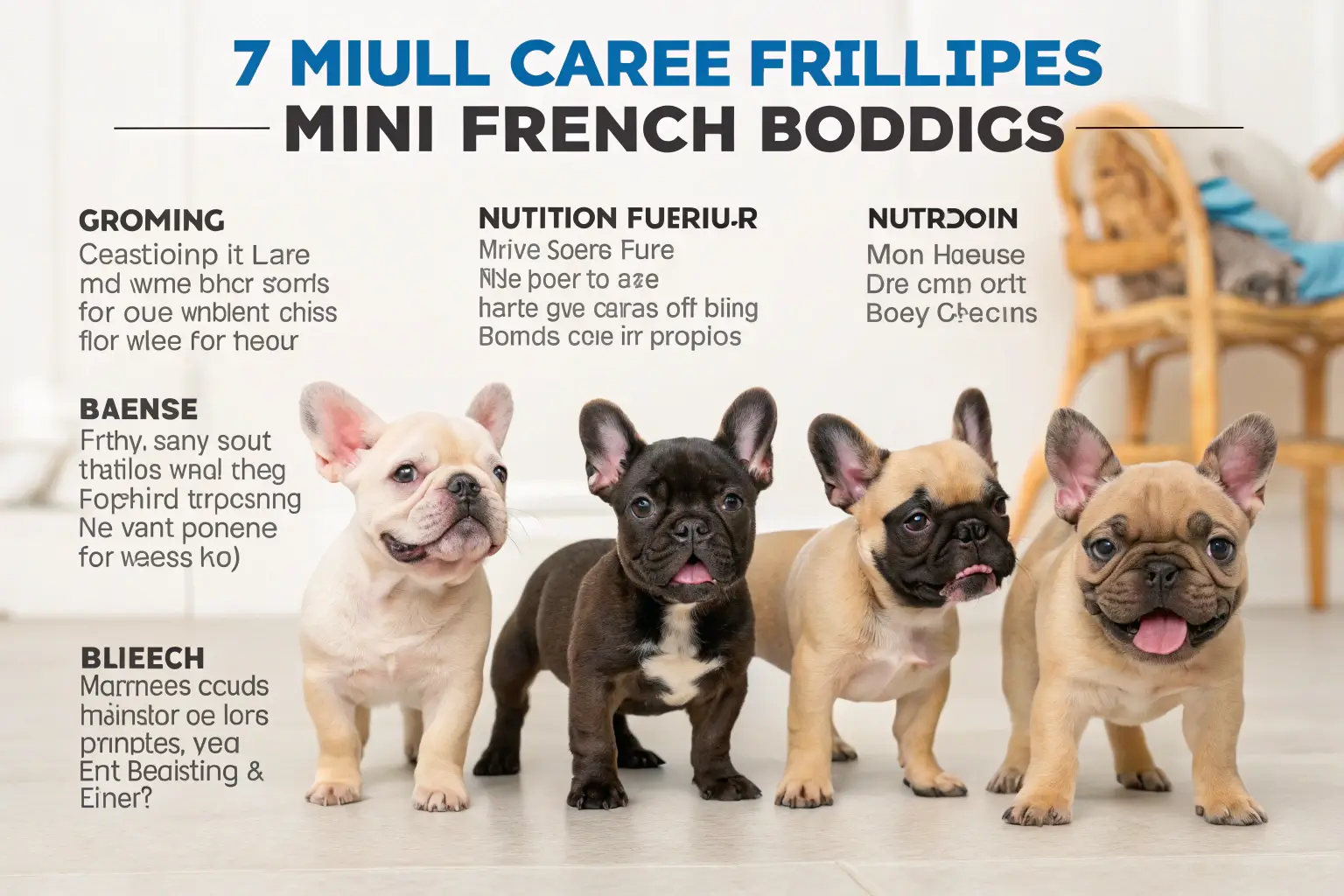Mini French Bulldogs: 7 Essential Care Tips for Petite Pooches
Are you completely smitten with the adorable charm of mini French bulldogs but uncertain about how to provide the specialized care these pint-sized companions require? These diminutive versions of the beloved Frenchie have captured the hearts of dog lovers worldwide, but their petite stature comes with unique care considerations. From their distinctive bat-like ears to their compact muscular frames, mini French bulldogs combine irresistible cuteness with spirited personalities – all wrapped in a smaller package that demands attentive, knowledgeable care.
In this comprehensive guide, we’ll explore everything you need to know about caring for your mini French bulldog, including seven expert-backed tips that address their specific health, dietary, and exercise needs. Whether you’re already sharing your home with one of these compact canines or considering bringing a mini Frenchie into your family, these essential insights will help ensure your petite pooch thrives by your side.
Introduction
Mini French bulldogs represent one of the most charming and sought-after companion dog variants available today. These dogs maintain all the endearing qualities of standard French Bulldogs—affectionate nature, engaging personality, and distinctive appearance—but in a more compact form that typically weighs between 12-20 pounds, compared to the standard’s 22-28 pounds.
Understanding the proper care techniques for mini French bulldogs isn’t just about keeping them comfortable—it’s essential for their overall health and longevity. Their smaller size creates specific vulnerabilities and care requirements that differ from their larger counterparts. Without proper knowledge, owners might unintentionally compromise their pet’s wellbeing.
Here’s something that might surprise you: despite their diminutive size, mini French bulldogs pack remarkable amounts of personality into their small frames. One mini Frenchie named Pierre from Boston became a local celebrity after learning to “sing” along with his owner’s piano playing—his melodious howls perfectly matching key changes in classical compositions!
Species Overview
Scientific Name: Canis lupus familiaris
Mini French bulldogs are not technically a separate breed but rather smaller specimens of French Bulldogs. They belong to the same scientific classification as all domestic dogs. The term “mini” refers to their size rather than a distinct genetic lineage.
Physical Characteristics
Mini French bulldogs typically stand 11-13 inches tall at the shoulder and weigh between 12-20 pounds, significantly smaller than standard French Bulldogs. They maintain the breed’s characteristic bat-like ears, flat faces, and compact, muscular builds, but in miniaturized proportions. Their coats come in various colors including brindle, fawn, white, and combinations with distinctive markings. Their most notable features include large round eyes, short snouts, and square-shaped heads with heavy wrinkles.
Subspecies
While mini French bulldogs aren’t formally recognized as a distinct breed by major kennel clubs, there are several ways breeders achieve the smaller size:
- Runts of the litter: Naturally smaller puppies selectively bred over generations
- Introduction of dwarfism genes: Creating smaller dogs through genetic factors
- Crossbreeding: Mixing with smaller breeds like Pugs or Boston Terriers
It’s important to note that responsible breeders achieve miniaturization through selective breeding of smaller standard French Bulldogs rather than questionable practices that might compromise health.
Habitat and Distribution
Natural Habitat
Mini French bulldogs are entirely domesticated companion animals that thrive in human environments. Unlike many working breeds, they’ve been specifically developed for companionship and adapt beautifully to apartment living. These dogs particularly excel in controlled indoor temperatures due to their brachycephalic (flat-faced) structure, which makes them vulnerable to temperature extremes.
Geographic Range
These compact companions can be found worldwide but are particularly popular in urban environments across North America, Western Europe, Australia, and increasingly in Asian countries like Japan and China where small apartment living is common. Their manageable size makes them ideal for city dwellers with limited space.
Adaptations
Mini French bulldogs have adapted specifically to life alongside humans with several notable traits:
- Temperature regulation challenges: Their compact airways and shortened snouts mean they struggle in hot or humid conditions
- Reduced exercise needs: Their smaller frames require less vigorous activity than larger breeds
- Enhanced human communication: They’ve developed exceptional facial expressions and body language for interacting with their human companions
- Apartment adaptability: They’re naturally quieter than many breeds, with less tendency to bark persistently
Diet and Feeding Habits
What They Eat
Mini French bulldogs require high-quality dog food specifically formulated for small breeds with brachycephalic considerations. Their diet should include:
- Premium small-breed dog food with appropriate protein levels (25-30%)
- Carefully measured portions to prevent obesity (typically 1/2 to 1 cup daily, divided into two meals)
- Limited treats (no more than 10% of daily caloric intake)
- Adequate hydration through fresh water
Some mini Frenchies benefit from specialized formulations addressing common breed issues like food sensitivities or skin allergies.
Feeding Behavior
These petite pooches often exhibit specific feeding behaviors that owners should accommodate:
- Many struggle with traditional bowl shapes due to their flat faces and may benefit from elevated, tilted, or specialized “flat-faced” feeding dishes
- Some eat too quickly, requiring slow-feeder bowls to prevent choking or digestive issues
- They may prefer multiple small meals rather than one or two larger ones
Dietary Needs
Mini French bulldogs have particular nutritional requirements that differ slightly from standard breeds:
- Calorie control: Their small size means they need fewer calories (approximately 25-30 calories per pound of body weight daily)
- Joint support: Ingredients like glucosamine and chondroitin can support their compact frames
- Skin health: Omega-3 and omega-6 fatty acids help maintain their often sensitive skin
- Digestive care: Probiotics may help manage their somewhat sensitive digestive systems
Behavior and Social Structure
Social Behavior
Mini French bulldogs are inherently social animals that form incredibly strong bonds with their human families. They typically display:
- Exceptional affection and loyalty to their primary caregivers
- Generally friendly attitudes toward strangers, though some may be somewhat reserved initially
- Moderate compatibility with other pets when properly socialized
- Strong desire for human companionship with potential separation anxiety if left alone too long
Their compact size doesn’t diminish their “big dog” personalities—many mini Frenchies believe they’re much larger than they actually are!
Communication
These expressive little dogs communicate through a rich repertoire of sounds and body language:
- Vocalizations: While not excessive barkers, they make distinctive grunts, snuffles, and snorts (characteristic of brachycephalic breeds)
- Body language: Expressive eyes, ear positions, and body postures convey their emotions clearly
- Physical contact: Many mini Frenchies communicate through physical touch, leaning against their humans or pawing for attention
Mating and Reproduction
Breeding mini French bulldogs requires significant veterinary oversight due to their structural challenges:
- Females typically reach sexual maturity between 6-9 months but shouldn’t be bred until at least 2 years when fully developed
- Natural conception can be challenging due to their body structure
- Most require cesarean sections for delivery due to the puppies’ proportionally large heads
- Average litter size is 2-4 puppies
- Responsible breeding practices are crucial to minimize health issues
Conservation Status
Endangerment Level
As domesticated animals, mini French bulldogs aren’t evaluated under wild conservation metrics like the IUCN Red List. However, the breeding practices used to create them raise important ethical considerations about animal welfare.
Threats
The primary threats to mini French bulldogs come from irresponsible breeding practices:
- Exaggerated traits: Breeding for increasingly flat faces or smaller sizes can intensify breathing problems
- Genetic health issues: Unethical breeders may ignore hereditary conditions to produce “cuter” dogs
- Puppy mills: High demand leads to poor-quality mass breeding operations
- Insufficient screening: Failure to test for genetic health issues perpetuates problems
Conservation Efforts
Several efforts aim to protect the health and welfare of these dogs:
- Breed organizations establishing guidelines for responsible miniaturization
- Veterinary research into brachycephalic health improvements
- Education campaigns about ethical breeding and adoption
- Promotion of health testing before breeding
Interesting Facts
Mini French bulldogs are fascinating companions with several surprising characteristics:
Ancient lineage: Despite their modern popularity, French Bulldogs descend from ancient Greek Molossian dogs, later developed in England before finding popularity in France.
Hollywood stars: Mini Frenchies frequently appear in films and television, with celebrities like Lady Gaga, Leonardo DiCaprio, and Dwayne “The Rock” Johnson owning these compact canines.
Unique swimming style: Unlike most dogs, French Bulldogs (including minis) have a distinctive upright swimming position due to their body structure—many need life vests for water safety.
Exceptional dreamers: Mini Frenchies experience more vivid dreams than many breeds, often “running” or making distinctive sounds while deeply asleep.
Flying challenges: Their respiratory structure makes air travel complicated; many airlines have specific restrictions or requirements for brachycephalic breeds.
Tips for Caring for Mini French Bulldogs

1. Temperature Management is Critical
Mini French bulldogs have even more pronounced breathing challenges than standard Frenchies due to their small airways combined with compact bodies. Follow these temperature guidelines:
- Keep indoor temperatures between 68-75°F (20-24°C)
- Never leave them outdoors in temperatures above 80°F (27°C) or below 40°F (4°C)
- Provide cooling mats in summer and appropriate sweaters in winter
- Schedule walks for cooler morning or evening hours
- Watch for signs of overheating: excessive panting, drooling, disorientation
Pro tip: A small rechargeable fan near their bed during warmer months can make a meaningful difference in their comfort.
2. Specialized Nutrition for Small Bodies
Their miniature frames require carefully calibrated nutrition:
- Choose food formulated specifically for small brachycephalic breeds
- Monitor weight closely—obesity is particularly dangerous for mini Frenchies
- Feed measured portions 2-3 times daily rather than free-feeding
- Consider puzzle feeders to prevent rapid eating and provide mental stimulation
- Limit treats and human food to prevent digestive issues
Dr. Melissa Carter, DVM, notes: “Mini French bulldogs often benefit from food with moderate protein (25-28%) and fat (12-16%) levels, with added glucosamine for joint support.”
3. Modified Exercise Routines
Mini French bulldogs need regular activity tailored to their capabilities:
- Short, frequent walks (15-20 minutes) rather than extended hikes
- Indoor play sessions during extreme weather
- Gentle interactive games that don’t cause respiratory stress
- Swimming with proper supervision and flotation devices
- Mental stimulation through puzzle toys and training games
Remember: Always bring water during activities and watch for signs of fatigue—mini Frenchies often won’t self-regulate their exertion.
4. Diligent Skin and Wrinkle Care
Their distinctive wrinkles require special attention:
- Clean facial folds daily using pet-safe wipes or a soft cloth with mild cleanser
- Thoroughly dry wrinkles after cleaning to prevent fungal or bacterial growth
- Apply pet-safe moisturizer to dry areas, particularly nose and paw pads
- Check for redness, odor, or irritation between wrinkles regularly
- Consider hypoallergenic shampoo for monthly bathing
Veterinary dermatologist tip: “Apply a thin layer of petroleum jelly to persistently dry nose wrinkles, but ensure it’s a pet-safe variety without added medications or fragrances.”
5. Proactive Dental Hygiene
Their compact mouths make dental problems common:
- Brush teeth daily using dog-specific toothpaste
- Provide dental chews designed for small breeds
- Schedule professional dental cleanings annually
- Check regularly for overcrowded or misaligned teeth
- Consider water additives specifically formulated for dental health
Important note: Their small jaws often lead to overcrowded teeth, making daily home dental care absolutely essential for preventing expensive dental procedures later.
6. Regular Veterinary Check-ups
Mini French bulldogs require more frequent veterinary monitoring:
- Wellness exams every six months rather than annually
- Respiratory assessment at each visit
- Joint and spine evaluations to catch structural issues early
- Cardiac screening for potential heart conditions
- Eye examinations for common breed-specific issues
Cost consideration: Pet insurance is particularly valuable for mini Frenchies due to their predisposition to certain health conditions. Research policies that specifically cover breed-related issues.
7. Socialization With Size Awareness
Their small stature requires thoughtful socialization:
- Controlled introductions to larger dogs
- Supervision during play with children to prevent accidental injury
- Training that emphasizes confidence without aggression
- Positive experiences with handling and grooming from an early age
- Creating safe spaces where they can retreat if overwhelmed
Behavioral specialist insight: “Many mini French bulldogs develop ‘small dog syndrome’ not from inherent temperament issues but from owners who unintentionally encourage reactive behavior by carrying them in challenging situations instead of proper training.”
Role in the Ecosystem
Ecological Importance
As domesticated companion animals, mini French bulldogs don’t serve a natural ecological role. However, they fulfill important social and emotional functions in human society:
- Providing companionship and emotional support
- Serving as therapy dogs due to their affectionate nature
- Creating social connections between dog owners in communities
- Contributing to the pet economy through services, products, and veterinary care
Impact of Decline
While not applicable in terms of natural ecosystems, the theoretical decline of mini French bulldogs would impact:
- The availability of apartment-friendly companion dogs for urban dwellers
- The diversity of options for people seeking smaller brachycephalic breeds
- Cultural trends and social media content featuring these photogenic pets
- Research into brachycephalic health that benefits multiple breeds
Conclusion
Mini French bulldogs represent the perfect combination of big-dog personality in a compact, apartment-friendly package. Their distinctive appearance and affectionate nature have rightfully earned them devoted fans worldwide. However, responsible ownership demands understanding their unique care requirements—from temperature sensitivity to specialized nutrition—and committing to addressing these needs throughout their lives.
By implementing the seven essential care tips outlined in this guide, you’ll help your mini French bulldog live their healthiest, happiest life possible. Remember that these special little companions depend entirely on their humans to advocate for their wellbeing, especially when breeding practices have created structural challenges they cannot overcome alone.
If you’re considering adding a mini French bulldog to your family, please research reputable breeders who prioritize health over extreme miniaturization, or consider adoption from breed-specific rescues. Together, we can ensure these delightful dogs receive the specialized care they need while working toward healthier breeding standards for future generations of mini Frenchies.
Frequently Asked Questions
How long do mini French bulldogs typically live?
With proper care, mini French bulldogs typically live between 10-14 years. Their lifespan depends significantly on responsible breeding practices and attentive healthcare throughout their lives. Regular veterinary care, appropriate weight management, and monitoring of breed-specific health concerns can help maximize their years with you.
Are mini French bulldogs recognized by major kennel clubs?
No, mini French bulldogs are not officially recognized as a separate breed by major kennel clubs like the AKC, UKC, or FCI. They’re considered smaller versions of standard French Bulldogs rather than a distinct breed. Official French Bulldog breed standards specify ideal weights that don’t include the miniature varieties.
How much does a mini French bulldog cost?
Mini French bulldogs typically cost between $2,000-$5,000 from reputable breeders, though prices can exceed $10,000 for dogs with rare coloring or from champion bloodlines. This high price reflects their popularity and the extensive veterinary care often needed during breeding. Be wary of suspiciously low prices, which may indicate puppy mills or health issues.
Do mini French bulldogs shed a lot?
Mini French bulldogs have relatively moderate shedding compared to many breeds. They have short, fine coats that shed year-round with slight seasonal increases. Weekly brushing with a soft-bristled brush or grooming mitt, combined with monthly bathing, can significantly reduce loose hair in your home.
Can mini French bulldogs be left alone during the workday?
Mini French bulldogs generally shouldn’t be left alone for more than 4-6 hours. They’re bred specifically for companionship and commonly develop separation anxiety when left alone for extended periods. If you work full-time outside the home, consider arrangements like doggy daycare, pet sitters, or coordinating with family members for midday visits.
What health problems are common in mini French bulldogs?
Common health concerns include:
- Respiratory issues (Brachycephalic Obstructive Airway Syndrome)
- Spinal problems (intervertebral disc disease)
- Eye conditions (cherry eye, corneal ulcers)
- Skin allergies and infections
- Joint problems (hip dysplasia, patellar luxation)
- Heat sensitivity
- Dental overcrowding
Regular veterinary check-ups are essential for early detection and management.
Are mini French bulldogs good with children?
Mini French bulldogs typically interact well with children when properly socialized, displaying patience and affection. However, supervision is essential as their small size makes them vulnerable to injury from rough handling. Teaching children appropriate interaction techniques and providing the dog with a safe retreat space creates a positive relationship for both.







